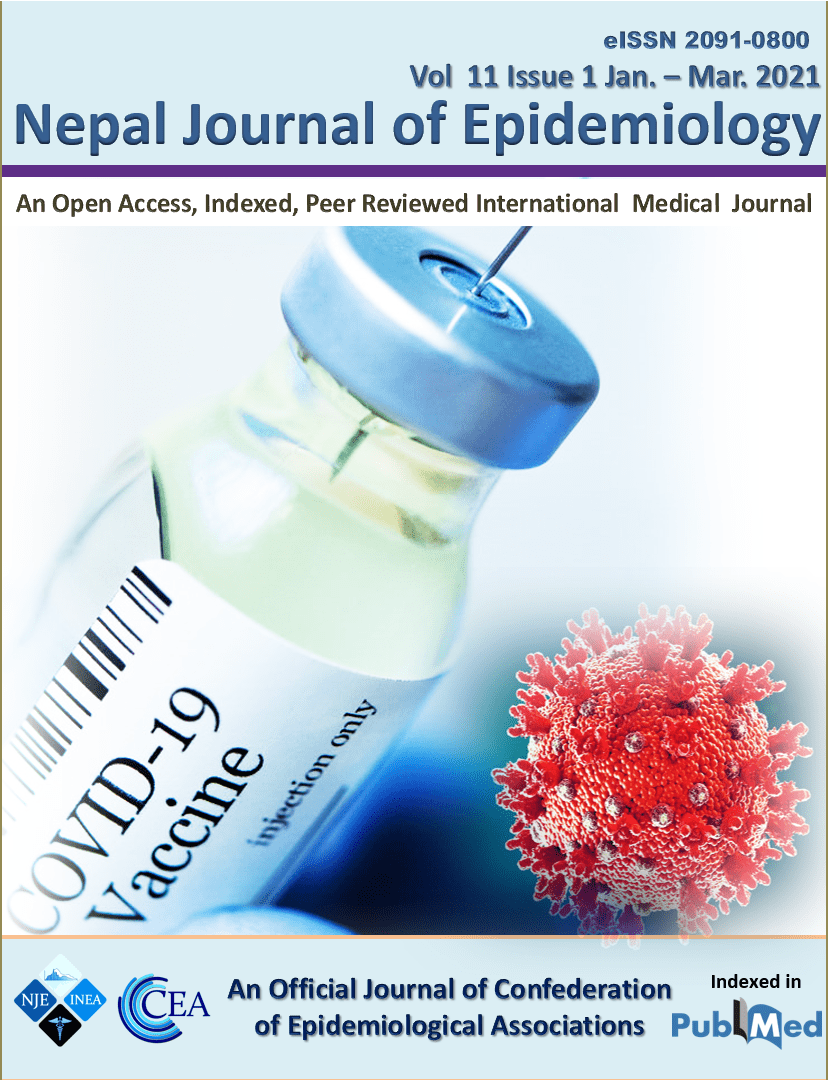A contemporary insight into the sero-epidemiology of Toxoplasma gondii infection in the foot-hills of Himalayas: A cross-sectional study from a tertiary care center in Northern India
DOI:
https://doi.org/10.3126/nje.v11i1.34228Keywords:
Toxoplasma gondii, Toxoplasmosis, Seroprevalence, Uttarakhand, north-India, factors associatedAbstract
Objective: Toxoplasma gondii (T. Gondii) infects 30-50% of the world human population with high diversity in geo-epidemiological data on its seroprevalence. Data on burden of toxoplasmosis and its determinants from remote and vulnerable regions of India are scarce. This study aimed to evaluate the prevalence of toxoplasma antibodies and factors associated with seropositivity among people from Uttarakhand and adjoining areas.
Methods: Serum samples from 442 cases were tested for anti-Toxoplasma IgG and IgM antibodies by Enzyme-linked Immunosorbent Assay. Correlation of seropositivity with age, sex, place of residence, dietary habits, and co-morbidity were analyzed by binary logistic regression.
Results: An overall Toxoplasma seropositivity of 36.88% [95% Confidence Interval (CI)=30.40–39.28] was observed. While anti-T. gondii IgG was present in 36.84% [95% CI=30.40–39.28], anti- T. gondii IgM was detected in 6.33% [95% CI=4.06–8.61]. The overall and IgG seroprevalence increased with age in both the genders and the slope was steeper after the age of 40 years [Adjusted Odds Ratio (AOR)=2.98, p-value=0.030]. The probability of seropositivity tended to be significantly higher in people from Uttarakhand in both the hilly region (AOR=5.61; 95%CI:[2.14-14.68]) and plains (AOR=5.14; 95%CI:[2.2-12.02]). Multivariable logistic regression analysis also showed that being rural residents (AOR=3.23; 95%CI:[1.67-6.23]) and presence of co-morbidity (AOR=8.64; 95%CI:[4.62-16.18]) were potential risk factors of Toxoplasmosis. Consumption of vegetarian diet was found to have a protective effect (AOR=0.46; 95%CI: [0.28-0.75]).
Conclusion: Seroprevalence of T. gondii antibodies was relatively high in Uttarakhand, particularly in rural and hilly terrain, indicating a necessity for the implementation of integrated public health strategies to prevent and control toxoplasmosis in this region.
Downloads
Downloads
Published
How to Cite
Issue
Section
License
- Upon acceptance Copyright on any research article is transferred in full to the Confederation of Epidemiological Associations (CEA) and International Nepal Epidemiological Association (INEA). The copyright transfer includes the right to reproduce and distribute the article in any form of reproduction (printing, electronic media or any other form).
- Articles in the Nepal Journal of Epidemiology are Open Access articles published under the Creative Commons CC BY License (https://creativecommons.org/licenses/by/4.0/)
- This license permits use, distribution and reproduction in any medium, provided the original work is properly cited.




